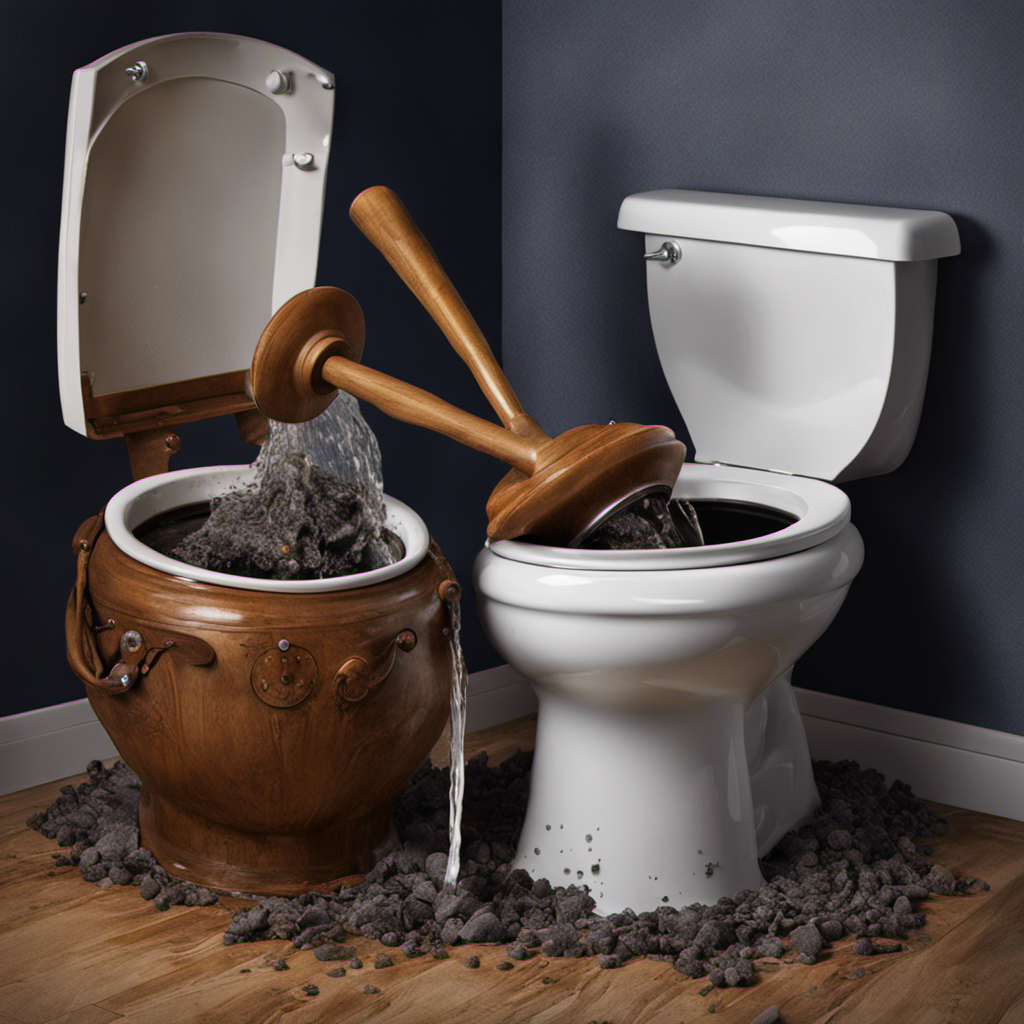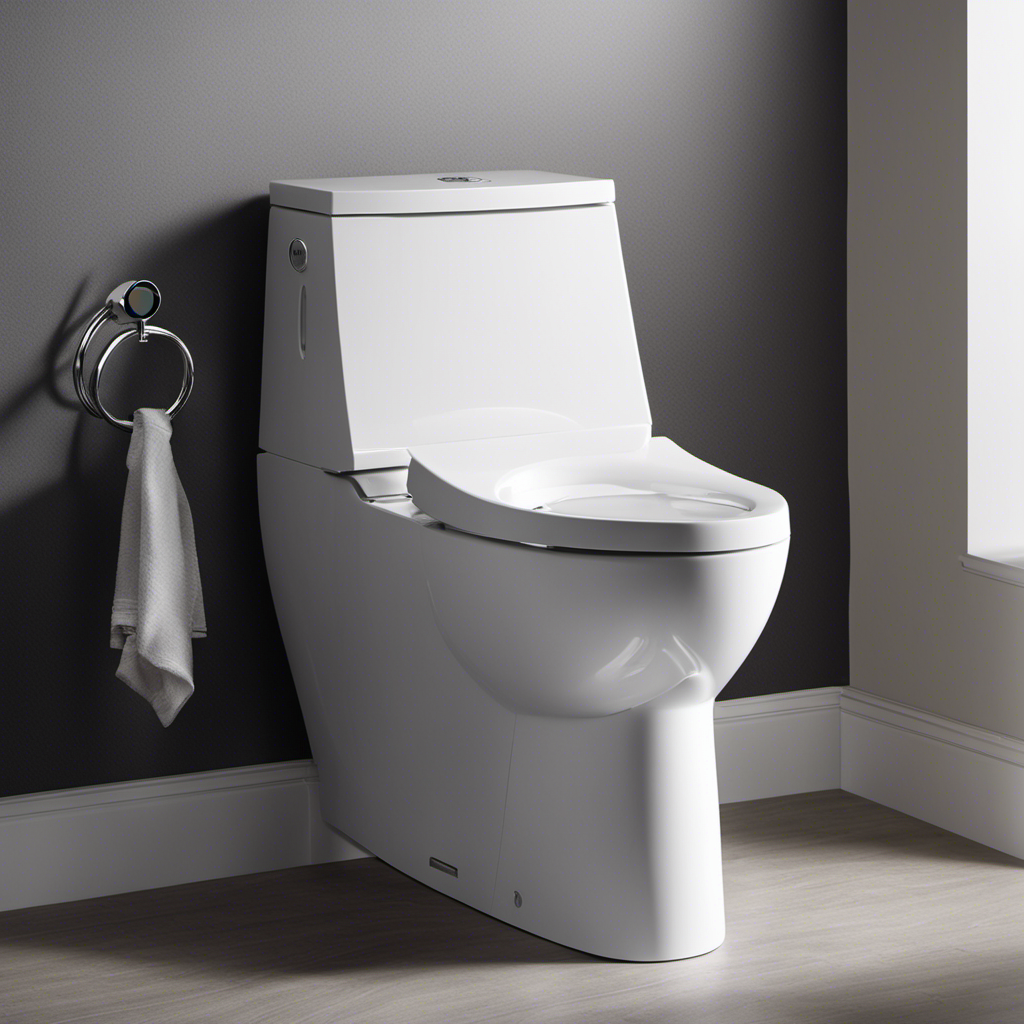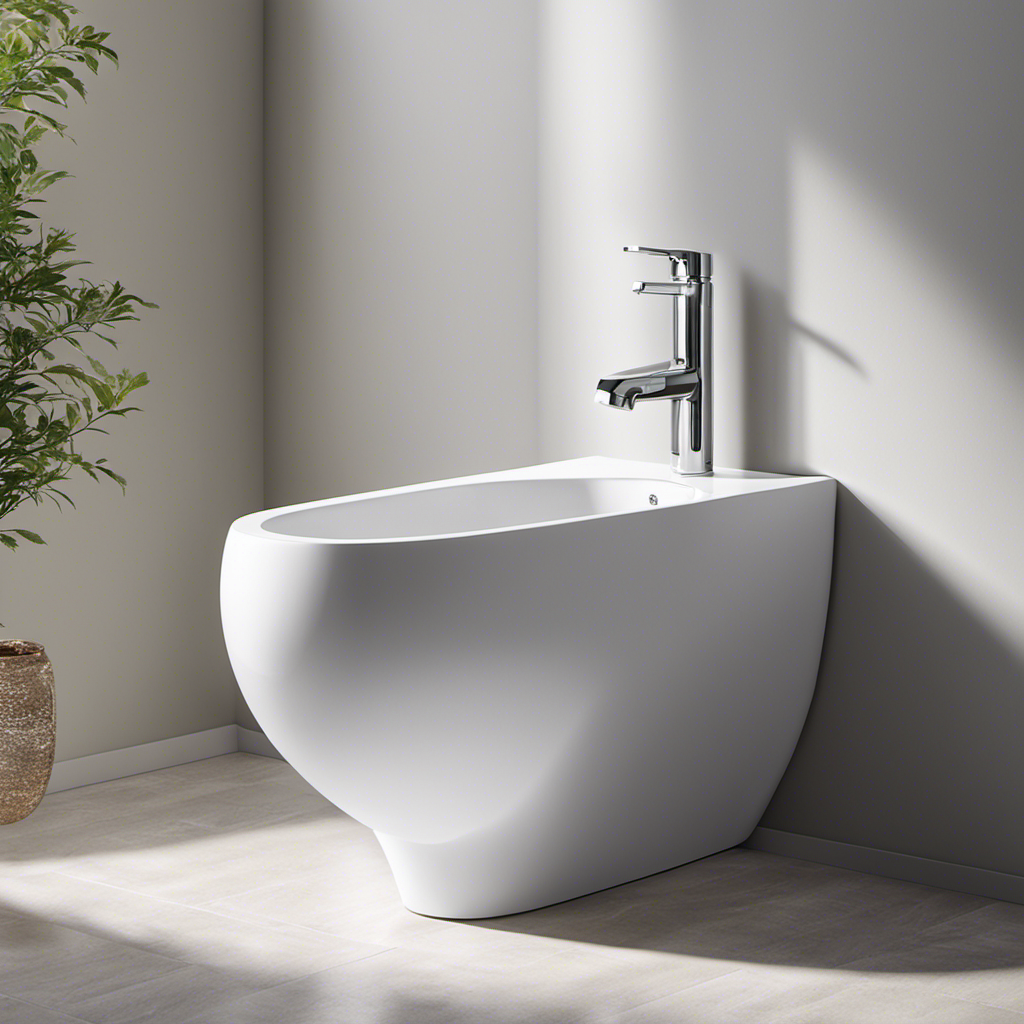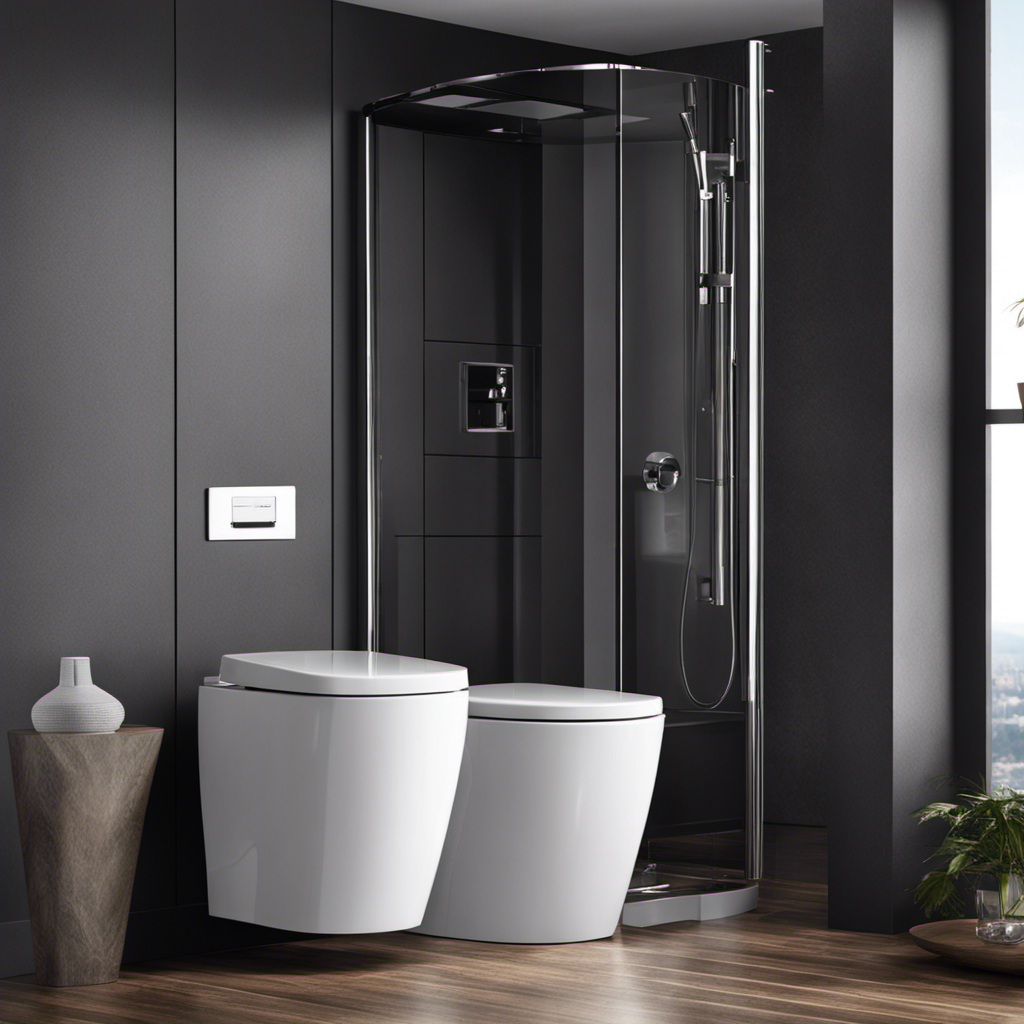Imagine the frustration of staring at a clogged toilet. But fear not, for you hold the power to fix the problem yourself.
In this step-by-step guide, we will walk you through the process of unclogging your toilet, from understanding the common causes to exploring effective DIY methods.
Armed with the right tools and a little know-how, you’ll soon bid farewell to those stubborn clogs.
So roll up your sleeves, and let’s get started!
Key Takeaways
- Flushing inappropriate items can cause toilet clogs, such as wet wipes, cotton balls, and sanitary products.
- Unclogging a toilet may require tools such as a plunger with a flange, a toilet auger or snake, a bucket or plastic bag for waste disposal, rubber gloves, and disinfectant cleaner.
- Steps to clear a clogged toilet include using a plunger with a flange, applying downward pressure and using quick, forceful plunges, trying hot water if the plunger doesn’t work, and using a toilet auger or snake for stubborn clogs.
- It is important to call a plumber if persistent clogs don’t respond to basic unclogging techniques, water backs up into other drains, foul odors come from the toilet or drains, multiple fixtures experience drainage issues, or if there is uncertainty or discomfort in unclogging the toilet.
Understanding the Common Causes of Toilet Clogs
Understanding the common causes of toilet clogs can help you prevent future plumbing issues. By knowing what commonly causes clogs, you can take preventive measures to keep your toilet running smoothly.
Here are some toilet clog prevention tips and troubleshooting common toilet problems:
-
Flushing inappropriate items: Avoid flushing anything other than toilet paper down the toilet. Items like wet wipes, cotton balls, and sanitary products can cause clogs.
-
Insufficient water flow: Make sure there is enough water flow when flushing. Low water levels can hinder the flushing process and lead to clogs. Adjust the water level in the tank if necessary.
-
Blocked trap: The trap, located near the base of the toilet, prevents sewer gases from entering your home. Clear any blockages in the trap using a plunger or a toilet auger.
Tools and Supplies You’ll Need for the Job
To effectively unclog a toilet, you will need a few essential tools and necessary supplies.
The first tool you’ll need is a toilet plunger, which is specifically designed for clearing toilet clogs. Make sure to choose a plunger with a flange, as it provides a better seal.
Additionally, you will need a toilet auger or snake, which is a long, flexible tool used to break up stubborn clogs.
Essential Tools for Unclogging
Grab the plunger and position it over the clogged toilet, making sure it forms a tight seal.
To effectively unclog the toilet, follow these steps:
- Apply downward pressure on the plunger to create a suction effect.
- Use quick, forceful plunges to dislodge the blockage.
- Be careful not to splash water around.
If the plunger doesn’t work, you may need to try other methods. Consider using a toilet auger or plumbing snake to reach deeper into the pipes and break up the obstruction. These tools are commonly used by plumbing services for stubborn clogs. Remember to read the instructions carefully and use them correctly to avoid causing damage.
With the toilet unclogged, it’s important to perform regular toilet maintenance to prevent future clogs. This includes avoiding flushing excessive amounts of toilet paper or non-flushable items and scheduling routine inspections by plumbing services.
Now that you know how to unclog a toilet, let’s move on to the necessary supplies for success.
Necessary Supplies for Success
Now that we have the plunger and auger ready, let’s discuss how to use them effectively.
When it comes to preventing clogs and finding eco-friendly solutions, there are a few necessary supplies you’ll need.
First, you’ll want to have a bucket or a plastic bag handy to dispose of any waste or debris. This will help keep the area clean and prevent further mess.
Next, make sure you have rubber gloves to protect your hands from any bacteria or germs.
Additionally, having a disinfectant cleaner on hand will allow you to thoroughly clean the toilet once the clog has been cleared.
Lastly, consider using natural, environmentally friendly cleaning products to maintain a sustainable approach throughout the unclogging process.
Step-by-Step Guide to Clearing a Clogged Toilet
When it comes to clearing a clogged toilet, understanding the plunger technique is essential.
First, make sure you have a good-quality plunger with a flange.
Next, place the plunger over the drain hole and create a tight seal. Use a combination of pushing and pulling motions to create suction and loosen the clog.
If the plunger technique doesn’t work, you can try using hot water to break up the clog. Carefully pour a bucket of hot water into the toilet bowl, allowing it to sit for a few minutes before attempting to flush.
However, if these methods don’t solve the problem, it may be time to call a plumber. A professional can assess the situation and provide the necessary expertise to unclog your toilet safely and efficiently.
Plunger Technique Explained
To unclog the toilet using a plunger, you should position the plunger over the drain and push down firmly. This creates a vacuum effect, dislodging the blockage and allowing the water to flow freely.
If you don’t have a plunger, there are a few alternatives and natural remedies you can try:
-
Hot Water Method:
-
Boil a pot of water.
-
Pour the hot water into the toilet bowl from waist height.
-
Let it sit for a few minutes.
-
Flush the toilet to see if the blockage clears.
-
Baking Soda and Vinegar Method:
-
Pour 1 cup of baking soda into the toilet bowl.
-
Add 2 cups of vinegar.
-
Let it sit for 30 minutes.
-
Flush the toilet to check if the clog is gone.
Using Hot Water
If you’re using hot water to clear a clog, make sure to pour it into the toilet bowl from waist height. Here’s a step-by-step guide on how to use hot water to unclog your toilet.
- Gather your materials: a bucket, a pot, and boiling water.
- Carefully pour the boiling water into the pot.
- Lift the pot to waist height and pour the hot water into the toilet bowl.
- Allow the hot water to sit in the bowl for a few minutes.
- Flush the toilet and see if the clog has cleared.
If the clog remains, try using a toilet auger.
- Insert the auger into the toilet bowl and turn the handle clockwise.
- Push the auger down, applying gentle pressure until you feel resistance.
- Slowly retract the auger, while continuing to turn the handle.
- Flush the toilet to check if the clog has been cleared.
Using boiling water and a toilet auger are effective methods to tackle stubborn clogs.
When to Call Plumber
It’s best to contact a plumber if the clog remains after attempting these methods. Sometimes, a clogged toilet can be more serious than it appears. Here are some signs that indicate you should call a professional:
- Persistent clog that doesn’t respond to basic unclogging techniques.
- Water backing up into other drains in your home.
- Foul odors coming from the toilet or drains.
- Multiple fixtures in your home experiencing drainage issues.
When you encounter any of these signs, it’s important to recognize that the clog requires the expertise of a plumber. They have the tools and knowledge to handle more complex clogs and prevent further damage to your plumbing system.
However, if you’re confident in your abilities and want to try some DIY methods first, here are some effective methods for unclogging a toilet.
Effective DIY Methods for Unclogging a Toilet
One effective DIY method for unclogging a toilet is using a plunger. To begin, make sure you have a plunger with a flange, as it provides a better seal. Position the plunger over the drain hole, ensuring that it covers the entire opening.
Next, push down firmly and then pull up quickly, repeating this motion several times. The suction created by the plunger will help dislodge the clog.
If the plunger doesn’t work, you can try using a toilet auger. Insert the auger into the drain hole and rotate the handle clockwise to break up the blockage.
However, avoid using chemical drain cleaners as they can damage your plumbing system.
In the next section, we will explore alternative solutions for stubborn clogs.
Exploring Alternative Solutions for Stubborn Clogs
Now, if the DIY methods we discussed earlier don’t work for your stubborn clog, don’t worry! There are still alternative solutions you can try. Here are two popular methods:
-
Boiling Water Method:
-
Begin by boiling a large pot of water on the stove.
-
Carefully pour the boiling water directly into the toilet bowl.
-
Allow the hot water to sit for a few minutes.
-
Flush the toilet to see if the clog has cleared.
-
Vinegar and Baking Soda Method:
-
Start by pouring one cup of baking soda into the toilet bowl.
-
Follow it up with two cups of vinegar.
-
Allow the mixture to sit for about half an hour.
-
Flush the toilet and check if the clog has been resolved.
Preventive Measures to Avoid Future Toilet Clogs
To prevent future clogs, make sure to regularly maintain your toilet by following these simple steps. Proper toilet maintenance can significantly reduce the chances of experiencing a clog and ensure the efficient functioning of your plumbing system. Here are a few preventive measures you can take:
| Measure | Description | Frequency |
|---|---|---|
| Watch what you flush | Avoid flushing items such as wipes, feminine hygiene products, or excessive toilet paper. These can easily cause clogs. | Every time you use the toilet |
| Regular cleaning | Clean the toilet bowl and jets regularly to remove any buildup that could lead to clogs. | Weekly |
| Inspect the flushing mechanism | Check the flapper, fill valve, and flush handle for any signs of wear or damage. Replace as necessary. | Every 6 months |
When to Seek Professional Help for a Clogged Toilet
If your toilet remains clogged after attempting basic troubleshooting, it may be time to call a professional for assistance. While there are several DIY methods for unclogging a toilet without using a plunger, some clogs may be too stubborn or complex to handle on your own.
Here are a few scenarios where seeking professional help is recommended:
- If you have tried using a toilet auger or a drain snake but the clog persists
- If you have attempted to use a chemical drain cleaner but it has not resolved the issue
Common mistakes to avoid when attempting to unclog a toilet include:
- Using excessive force when plunging, which can damage the toilet bowl or cause water to splash
- Flushing multiple times in quick succession, which can lead to overflow
- Pouring boiling water directly into the toilet bowl, which can crack the porcelain
Conclusion
To conclude, fixing a clogged toilet is a task that can be accomplished by following a few simple steps. By understanding the common causes of toilet clogs and having the necessary tools and supplies on hand, you can easily tackle the problem.
Utilizing effective DIY methods and exploring alternative solutions will help you overcome stubborn clogs. Additionally, implementing preventive measures will help avoid future toilet clogs.
Remember, if the clog persists or proves too challenging, it may be time to seek professional help.










